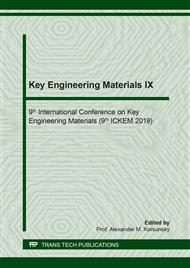p.237
p.244
p.250
p.256
p.263
p.273
p.280
p.287
p.294
Preparing the Melt for the Amorphous and Nanocrystalline State
Abstract:
The scientific as well as applied approach to addressing the problem of the particle’s liquid state structure should rely on experimental data related to the particular liquid; take into account the temperature interval of its existence, the history and the main aims of the investigation. Taking into account the concept of the quasi-chemical model of the liquid micro-non-uniform composition and the research made on the physical properties of the Fe-based melts being crystallized, the unique technology of the melt time-temperature treatment has been developed. Amorphous ribbons produced using this technology require optimal annealing temperatures to be specifically selected. The results of studying nanocrystalline magnetic core’ properties and their structure in the course of annealing at temperatures below and above the optimal ones are presented. In the amorphous ribbon obtained in the mode of preparation of the melt with overheating above the critical temperature, an enhanced value of the enthalpy of crystallization is found. After the heat treatments of the cores, the mode with overheating the melt above the critical temperature results in higher magnetic properties.
Info:
Periodical:
Pages:
263-269
Citation:
Online since:
September 2019
Price:
Сopyright:
© 2019 Trans Tech Publications Ltd. All Rights Reserved
Share:
Citation:


